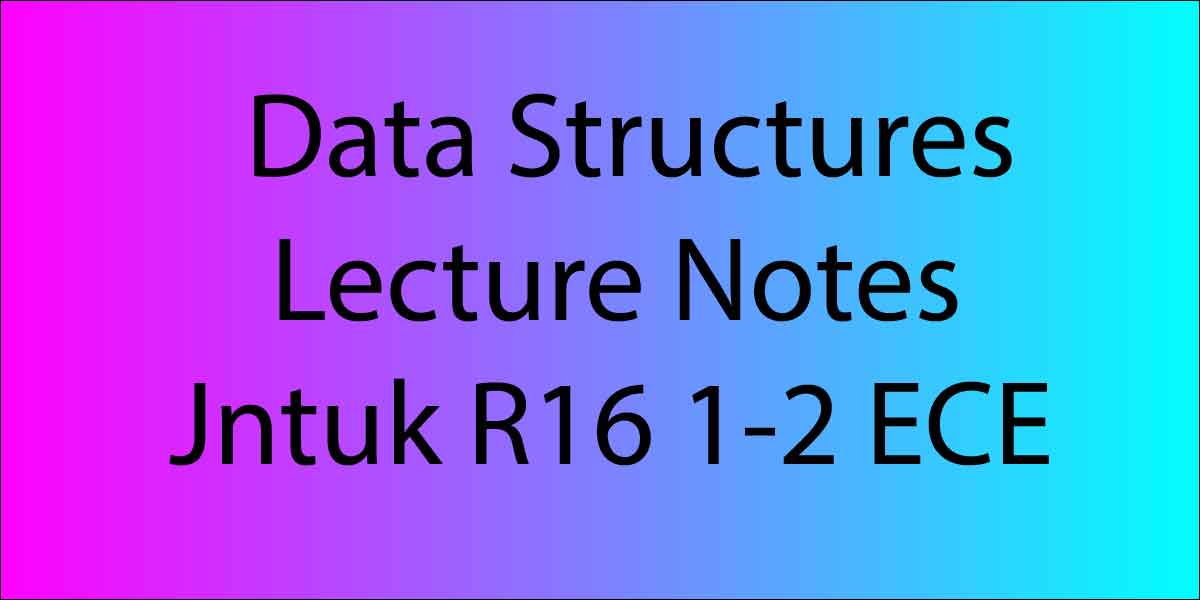Data Structures
OBJECTIVES:
• To be accustomed to basic techniques handling issues with knowledge structures • Solve issues exploitation knowledge structures like linear lists, stacks, queues, hash tables
UNIT-I:
ARRAYS Abstract knowledge sort, The Array as associate Abstract knowledge sort, The Polynomial Abstract knowledge type-Polynomial Representation- Polynomial Addition. Spares Matrices, Introduction- distributed Matrix Representation- Transposing a Matrix- matrix operation, illustration of Arrays.
UNIT-II:
STACKS AND QUEUES The Stack Abstract knowledge sort, The Queue Abstract knowledge sort, analysis of Expressions, Expression- ending Notation- Infix to ending.
UNIT-III:
joined LISTS Single joined List and Chains, Circular Lists, on the market area Lists, joined Stacks and Queues, Polynomials, Polynomial illustration- Adding Polynomials- Circular List Representation of Polynomials, Equivalence categories, distributed Matrices, distributed Matrix Representation- distributed Matrix Input- Deleting a distributed Matrix, Doubly joined Lists, Generalized Lists, illustration of Generalized Lists- algorithmic Algorithms for Lists- Reference Counts, Shared and algorithmic Lists
UNIT-IV:
TREES illustration of Trees, Binary Trees, The Abstract knowledge sort, Properties of Binary coiffure, Binary Tree Representations, Binary Tree Traversal, Introduction, Inorder Traversal Preorder Traversal, Postorder Traversal, Thread Binary Trees, Threads, Inorder Traversal of a rib Binary Tree, Inserting a Node into a rib Binary Tree, Heaps, Priority Queues, Definition of a liquid ecstasy Heap, Insertion into a liquid ecstasy Heap, Deletion from a liquid ecstasy Heap, Binary Search Trees, Definition, looking a Binary Search Tree, Insertion into a Binary Search Tree, Deletion from a Binary Search Tree, Height of Binary Search Tree.
UNIT-V:
GRAPHS The Graph Abstract knowledge sort, Introduction, Definition, Graph illustration, Elementary Graph Operation, Depth 1st Search, Breadth 1st Search, Connected elements, Spanning Trees, Biconnected elements, Minimum value Spanning Trees, Kruskal S algorithmic program, Prim s algorithmic program, Sollin’s algorithmic program, Shortest ways and transitive Closure, Single Source/All Destination: plus Edge value, Single Source/All Destination: General Weights, All-Pairs Shortest Path, transitive Closure.
I Year – II Semester
L T P C
4 0 0 3
DATA STRUCTURES
UNIT-VI:
SORTING Insertion type, Quick Sort, Merge type Merging, reiterative Merge type, algorithmic Merge type, Heap Sort, outline of Internal Sorting
OUTCOMES:
• Apply advanced organisation ways for exploring complicated knowledge structures.
• Compare and distinction numerous knowledge structures and style techniques within the space Of Performance.
• Implement all knowledge structures like stacks, queues, trees, lists and graphs and compare their Performance and trade offs
Text Books:
- knowledge structures, Algorithms and Applications in C++, S.Sahni, University Press (India) Pvt.Ltd, second edition, Universities Press Orient Longman Pvt. Ltd.
- knowledge structures and algorithmic program Analysis in C++, Mark Allen Weiss, Pearson Education. Ltd., Second Edition.
- knowledge structures and algorithms in C++, third Edition, Adam Drozdek, Thomson
Reference Books:
- knowledge structures and algorithmic program Analysis in C++, Mark Allen Weiss, Pearson Education. Ltd., Second Edition.
- knowledge structures exploitation C and C++, Langsam, Augenstein and Tanenbaum, PHI.
- downside finding with C++, The OOP, Fourth edition, W.Savitch, Pearson education.
[content-egg module=Amazon template=list]

